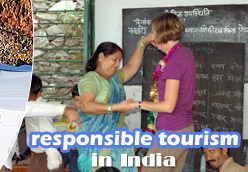INDIA is one of the oldest civilizations with a kaleidoscopic variety and rich cultural heritage. It has achieved multifaceted socio-economic progress during the last 61 years of its Independence. India has become self-sufficient in agricultural production and is now the tenth industrialized country in the world and the sixth nation to have gone into outer space to conquer nature for the benefit of the people. It covers an area of 32,87,2631 sq km, extending from the snow-covered Himalayan heights to the tropical rain forests of the south. As the seventh largest country in the world, India stands apart from the rest of Asia, marked off as it is by mountains and the sea, which give the country a distinct geographical entity. Bounded by the Great Himalayas in the north, it stretches southwards and at the Tropic of Cancer, tapers off into the Indian Ocean between the Bay of Bengal on the east and the Arabian Sea on the west. Lying entirely in the northern hemisphere, the mainland extends between latitudes 8°4' and 37°6' north, longitudes 68°7' and 97°25' east and measures about 3,214 km from north to south between the extreme latitudes and about 2,933 km from east to west between the extreme longitudes. It has a land frontier of about 15,200 km. The total length of the coastline of the mainland, Lakshadweep Islands and Andaman and Nicobar Islands, is 7,516.6 km.
CULTURE OF INDIA
The long span of Indian history covering 5000 years and enumerating several civilizations has been a constant reminder of the country's rich multicultural extravaganza and world-renowned heritage. The people and their lifestyles, their dance forms and musical styles, art & handicrafts, and such other elements go on to show the varied colors of Indian culture and heritage, which truly epitomizes the nationality of the country. India is a diverse country, a fact that is visibly prominent in its people, culture and climate. The food, clothing and habits of an Indian differ in accordance to the place of origin. The Indian culture varies with the geography. People speak different languages, dress differently, follow different religions, eat different food but are culturally bounded. So whether it is a festive occasion or a moment of grief, people participate whole-heartedly, feeling the happiness or pain.
Since ancient times, the spiritual land of India has displayed varied hues of culture, religion, race, language and geography. This variance accounts for the existence of different ethnic groups who profess different social habits and characteristics yet are bounded by the cultural spirit of India. Regional territories in India play an important role in differentiating these ethnic groups, with their own social and cultural identities. The religions that are prevalent in the country are Hinduism, Christianity, Islam, Sikhism, Buddhism, and Jainism, with the freedom for citizens to practice any religion they want to. The 28 different states and 7 union territories in the country, displaying different cultures, fuse through a common bond to showcase a national cultural identity.
CLIMATE
The Climate of India is broadly divided into four seasons
1) Winter: Occurring between January to March. The year's coldest months are December and January, when temperatures average around 10–15 °C (50–59 °F) in the northwest; temperatures rise as one proceeds towards the equator, peaking around 20–25 °C (68–77 °F) in mainland India's southeast.
2) Summer or pre-monsoon season: lasting from March to June (April to July in northwestern India). In western and southern regions, the hottest month is April; for northern regions, May is the hottest month. Temperatures average around 32–40 °C (90–104 °F) in most of the interior.
3) Monsoon or rainy season: lasting from June to September. The season is dominated by the humid southwest summer monsoon, which slowly sweeps across the country beginning in late May or early June. Monsoon rains begin to recede from North India at the beginning of October.
4) Post-monsoon season: lasting from October to December. South India typically receives more precipitation. Monsoon rains begin to recede from North India at the beginning of October. In northwestern India, October and November are usually cloudless. Parts of the country experience the dry northeast monsoon.
The Himalayan and northern states, being more temperate, experience an additional two seasons: autumn and spring.
REGIONS IN INDIA
(Links to the various sections in the regions in India page)
|













